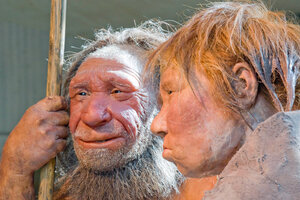The oldest Neanderthal DNA yet has been extracted and studied, highlighting the shift among anthropologists away from seeing Neanderthals as primitive humans.
 Researchers have sequenced the oldest Neanderthal DNA yet discovered, adding another layer of complexity to an emerging understanding of these ancient humans.
Researchers have sequenced the oldest Neanderthal DNA yet discovered, adding another layer of complexity to an emerging understanding of these ancient humans.
The DNA comes from 28 individuals found inside a Spanish cave, which anthropologists believe is home to a 400,000-year-old burial site. The researchers' findings from the site, called Sima de los Huesos, appeared Monday in the journal Nature.
“Sima de los Huesos is currently the only non-permafrost site that allow[s] us to study DNA sequences from the Middle Pleistocene, the time period preceding 125,000 years ago,” Matthias Meyer of the Max Planck Institute for Evolutionary Anthropology and lead author said in a press release.
Recommended:Are you scientifically literate? Take our quiz
Dr. Meyer praised the care taken in removing the samples from the cave, as technology had not yet advanced sufficiently for the limited DNA to be sequenced. The analysis of their mitochondrial DNA, obtained from a tooth, shoulder blade, and femur, revealed a relationship between the individuals and the Denisovans, an extinct Neanderthal group in Asia, wrote Ewen Callaway in an accompanying commentary.
“It’s fascinating and keeps us all on our toes trying to make sense of it all,” Chris Stringer, a palaeoanthropologist at the Natural History Museum in London, told Nature. “Instead of just being stuck with trying to resolve the last 100,000 years, we can really start to put some dates from DNA further down the human tree.”
The study sheds light on where different lineages may have diverged – and how long ago such divergences may have occurred.
"DNA sequences of the [Sima de los Huesos] hominins diverged more than twice as far back along the lineage from the Altai Neanderthal genome to its ancestor shared with the Denisovan genome than DNA sequences of the Late Pleistocene Neanderthals from Europe and the Caucasus," according to the study.
This study deepens understanding of Neanderthal history, but it also comes amid a growing shift in anthropological thought. A series of such finds are leading scientists to reject their original view that Neanderthals were very primitive ancestral humans.
"The evidence for cognitive inferiority is simply not there," Paola Villa, Colorado University-Boulder researcher and co-author of a 2014 paper on the cognitive abilities of Neanderthals, said in a press release. "What we are saying is that the conventional view of Neanderthals is not true."
Anthropologists are shifting our popular stereotype of an underdeveloped, even crass, Neanderthal as they discover more about these ancient humans' capabilities, Sudeshna Chowdhury wrote for The Christian Science Monitor:
Microfossils found in their teeth show that Neanderthals had a diverse diet that included aquatic foods, small and fast game such as birds and rabbits, date palms, and grass seeds.
Recent information available on "Neandertal use of ochre and manganese as well as on Neandertal production of pitch, the presence of transported and ochre-smeared shells, of ornaments such as eagle claws and perhaps bird feathers," goes to show that they had cultural rituals.
The earliest efforts to sequence the Neanderthal genome concluded in 2010 and suggested, as The Christian Science Monitor's Pete Spotts wrote, "We have met Neanderthals, and they are us – or about 1 to 4 percent of each of us." The genome, then only 60 percent complete, provided evidence that Neanderthals mated with human ancestors, thus preserving parts of the same genome that researchers found in a state of ancient preservation in Sima de los Huesos, Spain.
Since then, scientists have suggested that Neanderthals' intelligence led them to create art. Controversial evidence emerged in 2012 that paintings in another Spanish cave were too old to be the product of ancient Homo sapiens, Seth Borenstein wrote for the Associated Press. Although conflict exists among researchers, Neanderthals may have even created sculpture.
Such paintings are "one of the most exquisite examples of human symbolic behavior," Joao Zilhao, an anthropologist at the University of Barcelona, told the AP. "And that, that's what makes us human."




 Reply With Quote
Reply With Quote
Bookmarks